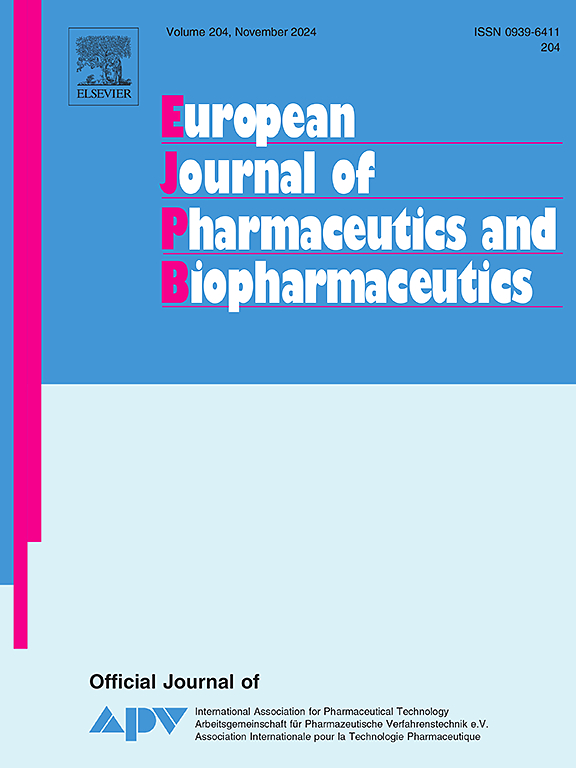从体外到体内:peg -脂质在LNP性能中的主导作用
IF 4.4
2区 医学
Q1 PHARMACOLOGY & PHARMACY
European Journal of Pharmaceutics and Biopharmaceutics
Pub Date : 2025-04-25
DOI:10.1016/j.ejpb.2025.114726
引用次数: 0
摘要
脂质纳米颗粒(LNPs)广泛用于递送核酸,如mRNA,在疫苗和治疗应用中。这些LNPs通常包括一种可电离脂质(通常为~ 50%),以促进核酸的包封,以及一种peg -脂质(通常为~ 1.5%),以增强纳米颗粒的稳定性。为了研究peg -脂质选择对LNP性能的影响,我们研究了两种不同酰基链长度的peg -脂质制备的LNP的物理化学特性和效力:DMG-PEG 2000和DSG-PEG 2000,分别含有14和18个碳尾长度。这些与三种常用的可电离脂质(ALC-0315, DLin-MC3和SM-102)结合。我们评估了这些LNPs在体外(HeLa细胞)和小鼠体内肌内(IM)、皮下(SC)和静脉(IV)给药后的疗效。体外研究表明,所有LNP制剂主要通过网格蛋白介导的内吞作用进入细胞。无论选择何种可电离脂质,DMG-PEG LNPs都比DSG-PEG LNPs表现出更高的体外mRNA转染效率。这些体外结果与所有给药途径的体内结果一致。我们的研究结果强调,尽管peg -脂质含量较低,但其选择对不同给药途径下LNP的疗效有重要影响,无论使用何种可电离脂质,基于dmg - peg的LNPs都优于DSG-PEG LNPs。本文章由计算机程序翻译,如有差异,请以英文原文为准。

From in vitro to in vivo: The Dominant role of PEG-Lipids in LNP performance
Lipid nanoparticles (LNPs) are widely employed for delivering nucleic acids, such as mRNA, in both vaccines and therapeutic applications. These LNPs generally include an ionisable lipid (typically ∼ 50 %) to facilitate nucleic acid encapsulation and a PEG-lipid (typically ∼ 1.5 %) to enhance nanoparticle stability. To examine how the choice of PEG-lipid impacts LNP performance, we investigated the physicochemical characteristics and potency of LNPs prepared using two PEG-lipids with different acyl chain lengths: DMG-PEG 2000 and DSG-PEG 2000, containing 14 and 18 carbon tail lengths, respectively. These were combined with three commonly used ionisable lipids (ALC-0315, DLin-MC3 and SM-102). We evaluated the efficacy of these LNPs both in vitro (HeLa cells) and in vivo in mice after intramuscular (IM), subcutaneous (SC), and intravenous (IV) administration. In vitro studies showed that all LNP formulations primarily enter cells via clathrin-mediated endocytosis. Irrespective of the choice of ionisable lipid, DMG-PEG LNPs demonstrated higher in vitro mRNA transfection efficacy than DSG-PEG LNPs. These in vitro results aligned with the in vivo outcomes across all routes of administration tested. Our findings emphasise that despite the low percentage content of PEG-lipid, its selection critically influences LNP efficacy across different administration routes, with DMG-PEG-based LNPs outperforming DSG-PEG LNPs, regardless of the ionisable lipid used.
求助全文
通过发布文献求助,成功后即可免费获取论文全文。
去求助
来源期刊
CiteScore
8.80
自引率
4.10%
发文量
211
审稿时长
36 days
期刊介绍:
The European Journal of Pharmaceutics and Biopharmaceutics provides a medium for the publication of novel, innovative and hypothesis-driven research from the areas of Pharmaceutics and Biopharmaceutics.
Topics covered include for example:
Design and development of drug delivery systems for pharmaceuticals and biopharmaceuticals (small molecules, proteins, nucleic acids)
Aspects of manufacturing process design
Biomedical aspects of drug product design
Strategies and formulations for controlled drug transport across biological barriers
Physicochemical aspects of drug product development
Novel excipients for drug product design
Drug delivery and controlled release systems for systemic and local applications
Nanomaterials for therapeutic and diagnostic purposes
Advanced therapy medicinal products
Medical devices supporting a distinct pharmacological effect.

 求助内容:
求助内容: 应助结果提醒方式:
应助结果提醒方式:


